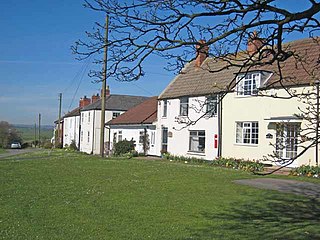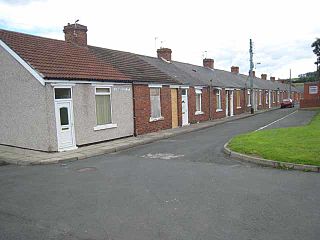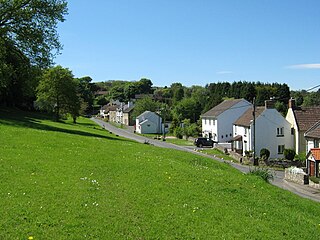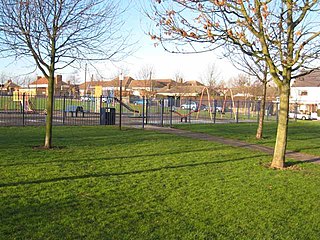
Binchester is a small village in County Durham, England. In 2001 it had a population of 271. It is situated between Bishop Auckland, which is to the south, and a short distance to the west of Spennymoor. It has a community centre, swing park and football field, and is surrounded by countryside. Granville Terrace, the main road through the village, was relaid and renovated in 1991 for the BBC television series Challenge Anneka.

Plawsworth is a village and former civil parish, now in the parish of Kimblesworth and Plawsworth, in the County Durham district, in the ceremonial county of Durham, England. It is situated a short distance to the east of Sacriston, on the A167 between Durham and Chester-le-Street. In 1961 the parish had a population of 1570.

Cockerton is an area in the north-west of Darlington in the borough of Darlington, County Durham, England. The Cocker Beck flows through the area and empties into the River Skerne via The Denes, an area and string of valleyed parks donated for the town in the early 20th century. It is also near Mowden, Branksome, West Park and Faverdale.

Cold Hesledon is a village and former civil parish, now in the parishes of Murton and Dalton-le-Dale, in the County Durham district, in the ceremonial county of Durham, England. It is situated a short distance to the east of Murton. In 1961 the parish had a population of 997.

Throston is an area of north Hartlepool within the borough of Hartlepool in County Durham, England. The area name is from the Anglo Saxon thosson meaning hill.

School Aycliffe is a village and former civil parish, now in the parish of Great Aycliffe, in the County Durham district, in the ceremonial county of Durham, England. It is a short distance west of Newton Aycliffe, and east of Heighington. Its name derives from a Viking called Scula, who owned land in that part of South Durham.

Mordon is a village and civil parish in County Durham, England. It is situated a few miles to the north-east of Newton Aycliffe. The population recorded by the 2011 census for the parish was 260.

Coundon Grange is a village in the civil parish of Dene Valley, in County Durham, England. It is situated to the east of Bishop Auckland. In the 2001 census Coundon Grange had a population of 235.

Newbiggin is a village and civil parish in County Durham, England. At the 2011 census the parish had a population of 146. It is situated on the north side of Teesdale, opposite Holwick. An influx of Derbyshire lead miners into the area in the late 18th century may have brought the name from Biggin. The village is within the North Pennines Area of Outstanding Natural Beauty (AONB).

Harrowgate Hill is a suburb of Darlington, in the Borough of Darlington, County Durham, England. The area includes the villages of Beaumont Hill, the Harrowgate Village as well as Ashbrook and Harrowgate Hill with the latter the largest part of the area.

Haughton-le-Skerne is a village in the borough of Darlington in the ceremonial county of Durham, England. It is situated in the north east of Darlington. The village lies to the west of the River Skerne. At the centre of the village green, is the main road towards Darlington town centre going across the river, south of the church. There used to be a linen mill on the riverbank on the east side of the village. Part of the mill leat can still be seen today.

Redworth is a village and former civil parish, now in the parish of Heighington in the borough of Darlington and the ceremonial county of Durham, England. It is west of Newton Aycliffe, between Darlington and Shildon. It had 190 residents at the time of the census in 2001. The name Redworth originates from the words Reed Worth, as the area was a large marsh. Redworth is home to Barcelo Redworth Hall, a 4 star hotel, which has been visited by many famous figures, including the England football team. Redworth Wood is filled with protected trees, and even a Stone Age fort, which has been pictured in the Northern Echo.

Sherburn House is a hamlet in the civil parish of Shincliffe, in County Durham, England. It is situated approximately 2 miles (3 km) south-east of Durham between Sherburn and Shincliffe Village.

The River Skerne is a tributary of the River Tees. It flows through County Durham in England.

East Rainton is a village and former civil parish, now in the parish of Hetton, in the Sunderland district, in the county of Tyne and Wear, England. It is situated alongside the A690 road between Sunderland and Durham, near Houghton-le-Spring. In 1931 the parish had a population of 1711. East Rainton was formerly a township and chapelry in the parish of Houghton-le-Spring, from 1866 East Rainton was a civil parish in its own right, on 1 April 1937 the parish was abolished to form Hetton, part also went to Houghton le Spring.

Wansford is a village and former civil parish, now in the parish of Skerne and Wansford, in the East Riding of Yorkshire, England. It is situated on the B1249 road and just to the north of the River Hull and the Driffield Canal. It is approximately 2.5 miles (4 km) south-east of Driffield and 3 miles (4.8 km) north-west of North Frodingham.

Morton Palms is a civil parish in the Darlington district, in the ceremonial county of Durham, England. In 2001 the parish had a population of 32. The parish borders Barmpton, Great Burdon, Hurworth, Middleton St. George, Neasham and Sadberge.

Great Eppleton is a hamlet in the civil parish of Hetton, in the Sunderland district, in the county of Tyne and Wear, England. It is about 6 miles south west of Sunderland city centre. Until 1974 it was in County Durham. In 1931 the parish had a population of 38. Today it consists of 2 farms.



















